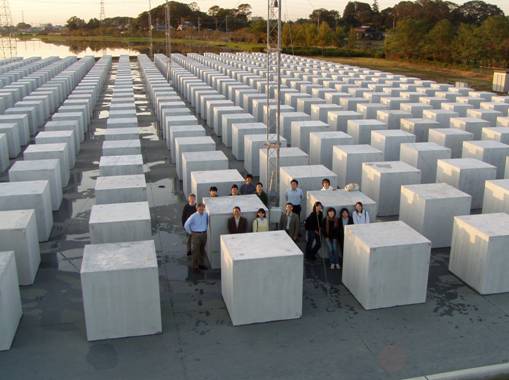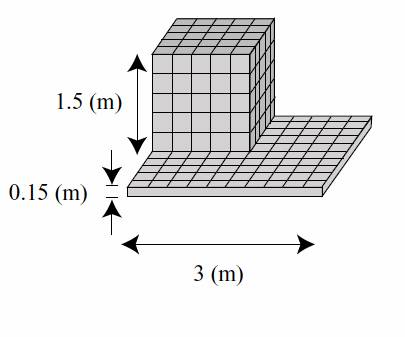| 1/5 larger scale model | |
| The 1/5 scale model is the main part of this project. The 1/5-scale model surface geometry consists of cubic concrete blocks 1.5-m on a side with 0.1-m thick walls. Inside blocks are vacant. The blocks are distributed in an array on concrete pavement that has a total area of 100 x 50 m2 (Figure 1). The area density and alignment of the concrete blocks are variable. The cubes are currently aligned in a square array with plane area density 0.25 (Figure 2). X, Y and Z are defined as the longer and shorter axes parallel to the streets, and the height from the concrete basement, respectively. The concrete pavement is flat with 1/200 inclination along Y axis to drain rainfall. The same concrete material was used for cubic block and basement. | |
 Figure 1 Plane view of the scale model site. (1), (2) and (3) indicate the locations of tower of the north, center, and south, respectively. |
 Figure 2 1/5 larger scale model |
For the water balance, a drainage system surrounding the concrete basement has an orifice at the exit that will allow us to estimate the water loss (rainfall / runoff) independent of the turbulent moisture flux. Three towers were constructed at X = 8 m, 50
m and 92 m along the central X-axis (Y = 0). Air temperatures were measured at several
heights of three towers using unshielded, 50-ƒÊm-thick
bare thermocouples. We judged from the observed vertical temperature profiles
that the depth of IBL ranged from Z/H = 2.5 to 4.0 at the distance of central
tower, where H is the cube height. Considering the minimum IBL height, a compact
sonic anemometer with 0.05 m sensor-span and 50 Hz sampling frequency (Kaijo TR90-AH),
and an infrared CO2/H2O open-path analyzer (LI-COR LI-7500) were installed at a height of 3 m
(Z/H = 2) of the central tower. They were used for the estimation of sensible
and latent heat fluxes through the eddy covariance (EC) method. Upward
and downward shortwave and longwave radiation were measured separately
using a radiation-balance meter (Eiko MR-40) 4.5 m above the ground (Z/H
= 3). |
|
 Figure 3 Cluster of heat plates on one model unit |
|